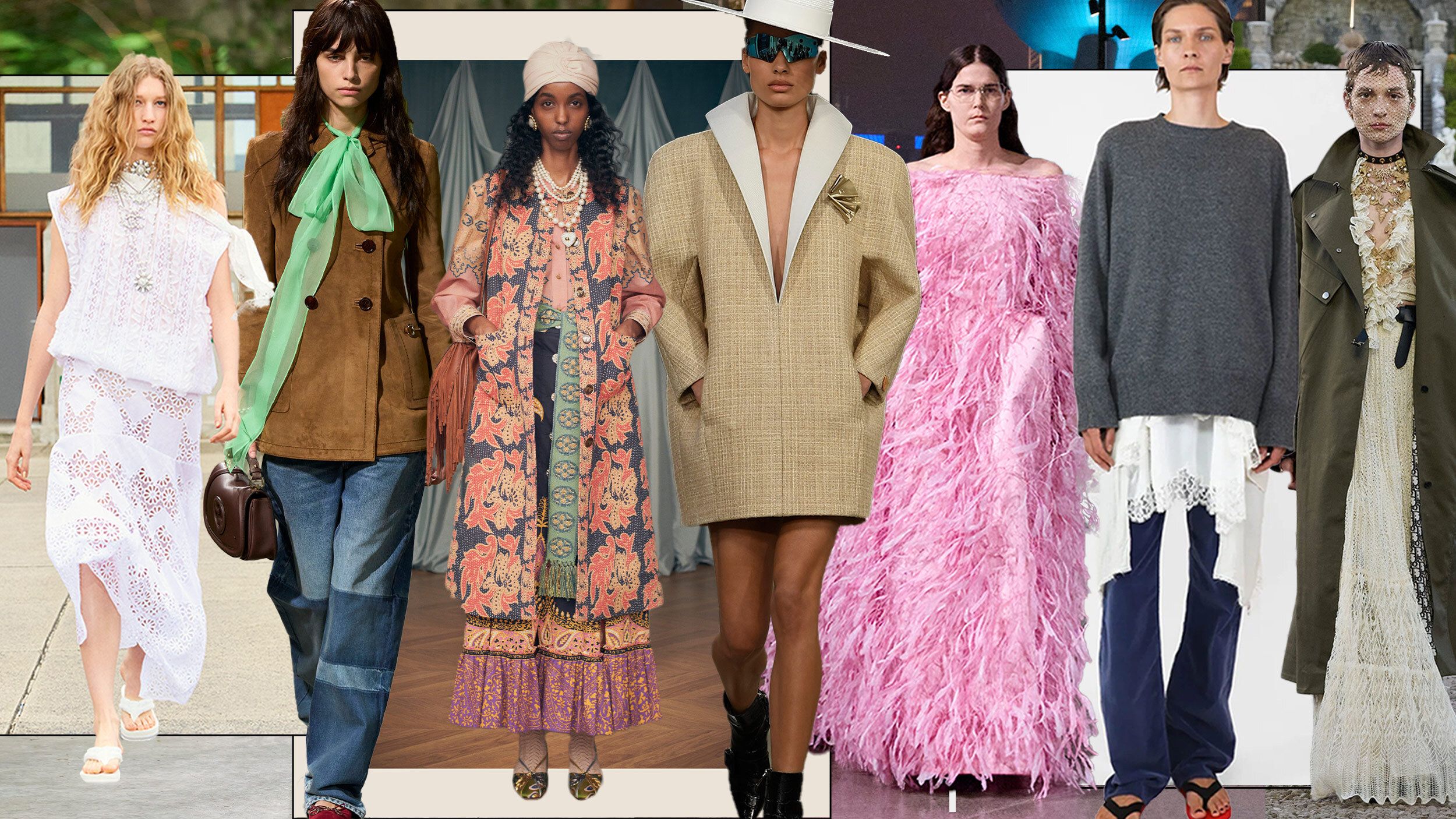Fashion is always evolving, with trends coming and going as designers push boundaries and consumers embrace or reject new ideas. The year 2025 is shaping up to be no different, with bold new styles emerging while some older trends fade into the background. From the rise of sustainable fashion to the resurgence of vintage aesthetics, let’s take a closer look at the hits and misses of the 2025 fashion landscape.
Hits: 2025 Fashion Trends That Captivated the World
%20(6)%20(1).png)
1. Sustainability and Eco-Friendly Fashion
One of the most impactful and widely embraced trends of 2025 is the continued focus on sustainable fashion. Consumers are increasingly demanding transparency from brands, leading to a rise in ethical practices, eco-friendly materials, and circular fashion systems. Designers are making waves with biodegradable fabrics, organic cotton, and innovative materials like lab-grown leather and recycled textiles.
The fashion industry has taken significant strides to reduce its carbon footprint, with zero-waste designs becoming a standard feature on runways. Brands like Stella McCartney and Patagonia are leading the charge, while fast fashion brands are being forced to rethink their production processes to keep up with consumer demand for greener options. This shift toward sustainability is more than a trend; it’s a necessary evolution for the future of fashion, and 2025 will be remembered as a milestone year for eco-friendly initiatives.
2. Gender Fluid Fashion
Another major hit in 2025 is the ongoing embrace of gender fluidity in fashion. The lines between traditionally “male” and “female” clothing have become increasingly blurred, with unisex collections dominating runways and retail spaces alike. From oversized suits to androgynous silhouettes, fashion is moving away from rigid gender norms and embracing a more inclusive approach.
Designers like Alessandro Michele of Gucci and Harris Reed are pushing this trend forward, creating collections that celebrate diversity and self-expression. The fashion industry is making space for people of all genders to express themselves freely through clothing, with gender-neutral fashion becoming a significant part of everyday wear.
3. Vintage Revival: 1970s and Y2K Nostalgia
Nostalgia continues to have a stronghold on fashion, and in 2025, two distinct eras are making a comeback: the 1970s and early 2000s (Y2K). The 1970s revival brings back bell-bottoms, suede, wide-brimmed hats, and earthy tones. Think bohemian dresses, fringe jackets, and platform shoes — all reimagined for the modern era with a contemporary twist.
On the other hand, Y2K fashion, characterized by low-rise jeans, baby tees, metallic fabrics, and chunky accessories, is resonating with Gen Z and Millennials alike. Brands like Blumarine and Diesel are tapping into this nostalgia, creating collections that appeal to those who lived through the early 2000s as well as those experiencing it for the first time.
The return of these retro aesthetics is a reminder of fashion’s cyclical nature, where old styles are continuously reinvented for new generations.
4. Tech-Infused Fashion
As technology continues to permeate every aspect of life, it’s no surprise that it’s having a significant impact on fashion as well. In 2025, tech-infused fashion is one of the most exciting developments. From smart fabrics that can monitor health metrics to clothes that change colour based on the wearer’s environment, fashion is becoming more functional and interactive.
Wearable technology, such as smartwatches and VR-integrated clothing, is also becoming a style statement. Designers are working with tech companies to create garments that not only look good but also serve practical purposes, making technology an integral part of fashion’s future. For instance, Balenciaga and Google are collaborating on a line of clothing that incorporates augmented reality experiences, blurring the line between digital and physical fashion.
5. Minimalism with a Twist
While maximalism has dominated runways in recent years, 2025 is seeing a shift back toward minimalism, albeit with a twist. The minimalist aesthetic is no longer just about clean lines and neutral colours; it’s about thoughtful design and understated luxury. Minimalist fashion in 2025 focuses on high-quality materials, impeccable tailoring, and timeless silhouettes that prioritize comfort without sacrificing style.
Designers like Phoebe Philo, known for her work at Celine, are at the forefront of this trend, creating pieces that are elegant yet simple. Minimalist fashion resonates with those who want to invest in long-lasting, versatile wardrobe staples rather than fleeting trends.
6. Bold Prints and Patterns
On the opposite end of the spectrum, bold prints and patterns are making a statement in 2025. From geometric designs to abstract art-inspired prints, fashion is embracing creativity and self-expression through vivid, eye-catching patterns. Animal prints, florals, and psychedelic motifs are particularly popular, often mixed and matched for an eclectic, vibrant look.
This trend has been embraced by designers like Versace and Moschino, whose collections are full of exuberant colours and patterns that make a bold fashion statement. In 2025, it’s all about standing out, and nothing does that quite like a daring print.
Misses: Trends That Fell Flat in 2025

1. Hyper-Exaggerated Streetwear
Streetwear has dominated fashion for the past decade, but in 2025, the trend of hyper-exaggerated streetwear is beginning to lose its appeal. Oversized logos, baggy silhouettes, and chunky sneakers have been ubiquitous for years, but fashion is moving toward more refined and tailored aesthetics.
While streetwear still has its place in fashion, the over-the-top elements are starting to feel tired and repetitive. Brands that have relied heavily on this style, like Supreme and Off-White, are facing criticism for lack of innovation. Consumers are craving something fresh and different, and hyper-exaggerated streetwear no longer feels like the cutting-edge trend it once was.
2. Micro-Mini Skirts
While Y2K fashion has made a successful comeback, not all elements of the early 2000s have aged well. Micro-mini skirts, in particular, are a trend that hasn’t resonated as much in 2025. The ultra-short hemline feels impractical for many, and with the growing emphasis on comfort and versatility in fashion, the micro-mini seems out of step with current consumer preferences.
Designers like Miu Miu and Chanel tried to bring back the micro-mini in their 2025 collections, but the trend has been met with lukewarm responses. Consumers are gravitating toward more comfortable and wearable options, making the micro-mini a miss in this year’s fashion landscape.
3. Extreme Cutouts
Cutouts have been a prominent feature in fashion for the past few years, but in 2025, extreme cutouts have lost their charm. While subtle cutouts can add an element of intrigue to a garment, the overly revealing designs that leave little to the imagination have started to feel gimmicky.
Designers like Tom Ford and Versace have been known for their bold, cutout-heavy designs, but in 2025, the trend is starting to feel overdone. Consumers are seeking more sophisticated and versatile pieces that can be worn in a variety of settings, and extreme cutouts don’t fit that mould.
4. Overly Puffy Sleeves
Puffy sleeves have been a major trend over the past few seasons, but in 2025, the exaggerated puff sleeve is starting to feel outdated. While a little volume can add drama and flair to an outfit, the overly puffy sleeves that dominated runways in recent years are now being seen as impractical and excessive.
Designers like Ulla Johnson and Cecilie Bahnsen, who were known for their voluminous sleeve designs, are starting to shift toward more subtle and refined silhouettes. Consumers are looking for pieces that are easy to wear and comfortable, and the cumbersome nature of puffy sleeves has caused this trend to fall out of favour.
5. Excessive Layering
Layering has long been a staple in fashion, but in 2025, excessive layering is becoming a miss. While layering can add depth and dimension to an outfit, too many layers can make an outfit look bulky and unflattering. The trend of wearing multiple layers, especially in oversized silhouettes, is starting to feel impractical and cluttered.
Consumers are opting for more streamlined looks that prioritize ease and comfort. The trend of excessive layering, popularized by brands like Rick Owens and Vetements, is losing steam as fashion moves toward a cleaner and more minimalist approach.
6. Plastic and Vinyl Materials
While sustainability is a major hit in 2025, the use of plastic and vinyl materials in fashion is becoming increasingly unpopular. These materials, often used for their shiny and futuristic aesthetic, are falling out of favour due to their negative environmental impact and uncomfortable feel.
Brands like Balmain and Mugler, known for their use of vinyl in past collections, are facing criticism as consumers become more environmentally conscious. The trend of plastic and vinyl in fashion feels out of touch with the growing demand for eco-friendly and sustainable alternatives, making it a miss in 2025.
Fashion in 2025 is a dynamic mix of innovation, nostalgia, and sustainability. Hits like eco-friendly fashion, gender fluidity, and the revival of vintage styles are capturing the imagination of designers and consumers alike. At the same time, certain trends, such as hyper-exaggerated streetwear and extreme cutouts, are starting to lose their appeal.

As fashion continues to evolve, the hits and misses of 2025 reflect a broader shift toward inclusivity, sustainability, and individuality. With consumers increasingly seeking meaningful and lasting fashion choices, the trends that succeed are those that prioritize comfort, versatility, and ethical production. As the year progresses, it will be fascinating to see how these trends continue to shape the future of fashion.
Amazon Echo Show 15 Review: Transforming Smart Home Control in a Whole New Way



